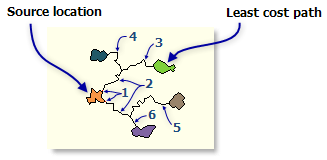| Label | Explanation | Data Type |
Input Destination Raster or Features | An image service or feature service that identifies the cells from which the least-cost path is determined to the least costly source. If the input is an image service, the input consists of cells that have valid values (zero is a valid value), and the remaining cells must be assigned NoData. | Raster Layer; Image Service; Feature Layer; String |
Input Cost Distance Raster | The name of a cost distance image service to be used to determine the least-cost path from the destination locations to a source. The cost distance raster is usually created with the Calculate Travel Cost tool. The cost distance raster stores, for each cell, the minimum accumulative cost distance over a cost surface from each cell to a set of source cells. | Raster Layer; Image Service; String |
Input Cost Backlink Raster | The name of a cost back link raster used to determine the path to return to a source via the least-cost path. For each cell in the back link raster, a value identifies the neighbor that is the next cell on the least accumulative cost path from the cell to a single source cell or set of source cells. | Raster Layer; Image Service; String |
Output Name | The name of the output travel cost paths raster service. The default name is based on the tool name and the input layer name. If the layer name already exists, you will be prompted to provide another name. | String |
Destination Field (Optional) | A field on the destination layer that holds the values that define each destination. Input feature service must contain at least one valid field. | String |
Path Type (Optional) | Defines the manner in which the values and zones on the input destination data will be interpreted in the cost path calculations.
| String |
Derived Output
| Label | Explanation | Data Type |
| Output Raster | The output raster. | Raster Layer |

 portal that has an
portal that has an 